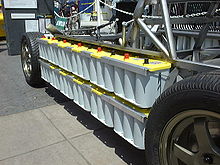
Back Akkupack German Akupatarei Estonian باتری پک Persian Batterie d'accumulateurs French Batri akimilatè HT Pacco batteria Italian 電池パック Japanese 전지팩 Korean Accupack Dutch 電池組 Chinese
This article needs additional citations for verification. (January 2024) |

A battery pack is a set of any number of (preferably) identical batteries or individual battery cells.[1][2] They may be configured in a series, parallel or a mixture of both to deliver the desired voltage and current. The term battery pack is often used in reference to cordless tools, radio-controlled hobby toys, and battery electric vehicles.
Components of battery packs include the individual batteries or cells, and the interconnects which provide electrical conductivity between them.[3] Rechargeable battery packs often contain voltage and temperature sensors, which the battery charger uses to detect the end of charging.[4] Interconnects are also found in batteries as they are the part which connects each cell, though batteries are most often only arranged in series strings.
When a pack contains groups of cells in parallel there are differing wiring configurations which take into consideration the electrical balance of the circuit. Battery Management System are sometimes used for balancing cells in order to keep their voltages below a maximum value during charging so as to allow the weaker batteries to become fully charged, bringing the whole pack back into balance.[5] Active balancing can also be performed by battery balancer devices which can shuttle energy from strong cells to weaker ones in real time for better balance.[5] A well-balanced pack lasts longer and delivers better performance.[6][1]
For an inline package, cells are selected and stacked with solder in between them. The cells are pressed together and a current pulse generates heat to solder them together and to weld all connections internal to the cell.
- ^ a b Hassini, Marwan; Von Hohendorff Seger, Pedro; Redondo-Iglesias, Eduardo; Pelissier, Serge; Venet, Pascal (27 October 2023). "Capacity Dispersion and Impact of Outliers in a Second Life Battery". 2023 IEEE Vehicle Power and Propulsion Conference (VPPC). Milan, Italy. pp. 1–4. doi:10.1109/VPPC60535.2023.10403384. ISBN 979-8-3503-4445-5. S2CID 267337334.
{{cite book}}: CS1 maint: location missing publisher (link) - ^ Li, Wei; Garg, Akhil; Xiao, Mi; Peng, Xiongbin; Le Phung, My Loan; Tran, Van Man; Gao, Liang (2020-10-10). "Intelligent optimization methodology of battery pack for electric vehicles: A multidisciplinary perspective". International Journal of Energy Research. 44 (12): 9686–9706. Bibcode:2020IJER...44.9686L. doi:10.1002/er.5600. ISSN 0363-907X.
- ^ Harper, Gavin; Sommerville, Roberto; Kendrick, Emma; Driscoll, Laura; Slater, Peter; Stolkin, Rustam; Walton, Allan; Christensen, Paul; Heidrich, Oliver; Lambert, Simon; Abbott, Andrew; Ryder, Karl; Gaines, Linda; Anderson, Paul (6 November 2019). "Recycling lithium-ion batteries from electric vehicles". Nature. 575 (7781): 75–86. Bibcode:2019Natur.575...75H. doi:10.1038/s41586-019-1682-5. ISSN 1476-4687. PMID 31695206.
- ^ Simpson, Chester (1995). "Battery charging" (PDF). National Semiconductors.
- ^ a b Cao, Jian; Schofield, Nigel; Emadi, Ali (2008). "Battery balancing methods: A comprehensive review". 2008 IEEE Vehicle Power and Propulsion Conference. pp. 1–6. doi:10.1109/VPPC.2008.4677669. ISBN 978-1-4244-1848-0. S2CID 42399871. Retrieved 2024-01-19.
- ^ Duraisamy, Thiruvonasundari; Kaliyaperumal, Deepa (2020-06-01). "Active cell balancing for electric vehicle battery management system". International Journal of Power Electronics and Drive Systems (IJPEDS). 11 (2): 571. doi:10.11591/ijpeds.v11.i2.pp571-579. ISSN 2722-256X.
© MMXXIII Rich X Search. We shall prevail. All rights reserved. Rich X Search